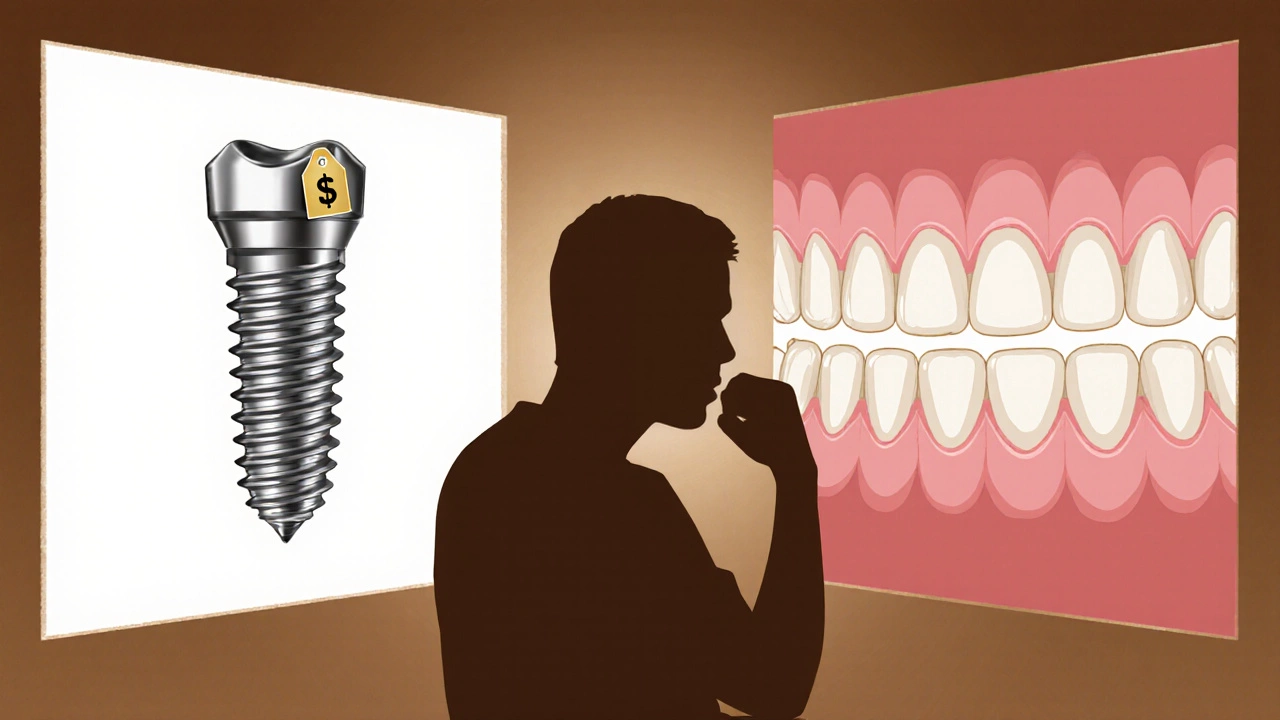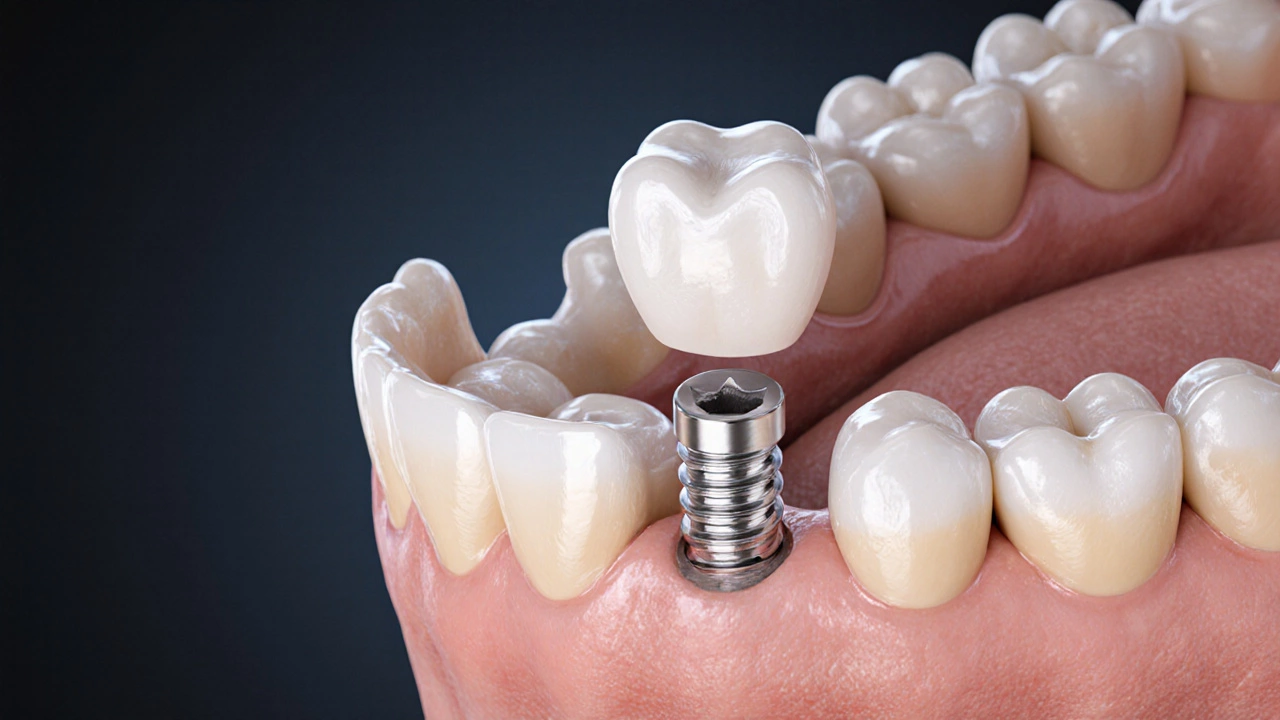Dental Implant Cost Calculator
Calculate Your Implant Costs
Get an estimate for the total cost of a dental implant procedure including all common additions and long-term maintenance.
Estimated Total Cost
$0
Base Cost: $0
Additional Procedures: $0
Long-Term Maintenance: $0
Note: These estimates are based on average industry costs. Actual prices may vary by dentist, location, and individual circumstances.
Important: Dental insurance rarely covers implants as they're typically considered cosmetic.
Thinking about swapping a missing tooth for a dental implant? It sounds like a win: permanent, natural‑looking, and sturdy. But every silver lining has a cloud. Below we break down the most common downsides, so you know exactly what you might be signing up for before you walk into the dentist’s chair.
What a Dental Implant Actually Is
Dental implant is a tiny titanium post surgically placed into the jawbone to act as an artificial tooth root. It fuses with bone through a process called osseointegration, providing a stable base for a crown or bridge. The idea is simple, yet the surgery, healing, and long‑term maintenance bring several potential headaches.
Major Risks and Complications
Even though many patients enjoy smooth outcomes, a handful of issues can turn the experience sour:
- Infection: Any surgical site can get infected. If bacteria invade the implant area, you could face pain, swelling, or even implant loss.
- Peri‑implantitis: This is an inflammatory condition that attacks the tissue and bone around the implant. Peri‑implantitis can cause bone loss, gum recession, and eventual implant failure if not caught early.
- Implant failure: Not all implants integrate properly. A failed implant may wobble or become loose, often requiring removal and a repeat surgery.
- Nerve damage: In the lower jaw, the implant drill can brush against the inferior alveolar nerve, leading to temporary or, rarely, permanent tingling or numbness.
- Allergic reaction: While rare, some people react to the titanium alloy, resulting in inflammation or rejection.
Why Healing Time Matters
After the post is placed, the jawbone needs weeks-or even months-to fully fuse with the titanium. During this Osseointegration phase can take 3 to 6 months for the upper jaw and up to 9 months for the lower jaw, you’ll have a temporary crown or none at all. Patience is a must, especially if you need the tooth back for work or social events.
Cost Considerations
Dental implants aren’t cheap. In the United States, a single implant can range from $3,000 to $6,000, including surgery, the abutment, and the crown. In India, prices are lower-often between ₹30,000 and ₹70,000-but still a sizable investment.
Beyond the upfront fee, there are hidden costs to watch out for:
- Bone grafts: If you lack sufficient jawbone, a graft may be needed, adding $500‑$2,000 to the bill. Bone graft uses donor material or synthetic substitute to build up the jaw before implant placement.
- Follow‑up visits: Radiographs, cleaning, and occasional adjustments can add up over the years.
- Replacement parts: The crown may need replacement after 10‑15 years due to wear.
Long‑Term Maintenance
Just because an implant looks like a natural tooth doesn’t mean it’s maintenance‑free. You’ll need diligent oral hygiene to prevent gum disease and peri‑implantitis. Flossing around the implant can be trickier, and you might need special interdental brushes.
Regular dental check‑ups become even more crucial. Dentists will typically take a Radiograph X‑ray that shows bone levels around the implant and detects early signs of infection annually.

Who Should Think Twice?
Not everyone is a perfect candidate. Consider these red flags before you commit:
- Heavy smokers: Nicotine restricts blood flow, raising infection risk and slowing bone healing.
- Uncontrolled diabetes: High blood sugar hampers wound healing and can increase infection rates.
- Insufficient bone volume: Without enough jawbone, you’ll need grafting, which adds time and cost.
- Existing gum disease: Active periodontitis must be treated first, or the implant may fail.
Dental Implant vs. Dental Bridge: A Quick Comparison
| Aspect | Dental Implant | Dental Bridge |
|---|---|---|
| Initial cost | High ($3k‑$6k per tooth) | Lower ($500‑$1,500 per unit) |
| Surgical risk | Infection, nerve damage, implant failure | None (no surgery) |
| Healing time | 3‑9 months for osseointegration | Immediate after placement |
| Effect on adjacent teeth | None - preserves neighbors | Requires filing down healthy teeth |
| Long‑term maintenance | Strict hygiene, possible peri‑implantitis | Standard cleaning, lower risk of gum disease |
Checklist Before You Say Yes
Use this quick list to decide whether a dental implant is worth the trade‑offs:
- Do you have a healthy jawbone or are you willing to undergo a bone graft?
- Can you afford the upfront cost plus potential extras?
- Are you a smoker or have uncontrolled health conditions?
- Are you prepared for a multi‑month healing period?
- Do you commit to rigorous daily cleaning and regular dental visits?
If you answered “yes” to most, implants can be a great long‑term solution. If you hesitated on several points, discuss alternatives with your dentist.
Bottom Line
Dental implants offer durability and a natural look, but they come with surgical risks, a hefty price tag, and a demanding maintenance routine. Knowing the downsides helps you weigh the benefits against the costs-and avoid unpleasant surprises down the road.

Can dental implants fail even after they look successful?
Yes. An implant can appear stable initially but later develop peri‑implantitis or lose osseointegration, leading to loosening or loss of the implant.
How long does the entire implant process take?
From the first consultation to the final crown, expect 4 to 9 months. Smoking, bone grafts, or complications can extend this timeline.
Is the cost of a dental implant covered by insurance?
Most dental insurance plans treat implants as cosmetic, so coverage is limited. Some medical plans may cover part of the procedure if it’s deemed medically necessary.
What’s the best way to prevent peri‑implantitis?
Brush twice daily with a soft‑bristle toothbrush, floss daily using implant‑specific floss or interdental brushes, and schedule regular dental clean‑ups that include professional imaging.
Are there alternatives for patients who can’t get implants?
Yes. Options include traditional dental bridges, removable partial dentures, or newer hybrid solutions like zirconia resin‑bonded bridges that don’t require surgery.






